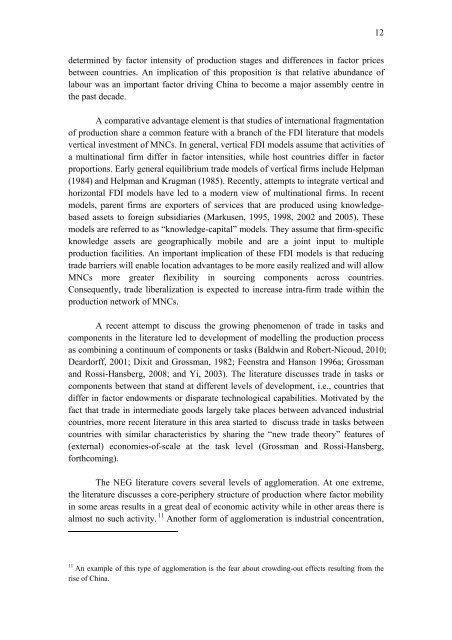Chapter I Driving forces of Asian international production ... - escap
Chapter I Driving forces of Asian international production ... - escap
Chapter I Driving forces of Asian international production ... - escap
You also want an ePaper? Increase the reach of your titles
YUMPU automatically turns print PDFs into web optimized ePapers that Google loves.
determined by factor intensity <strong>of</strong> <strong>production</strong> stages and differences in factor prices<br />
between countries. An implication <strong>of</strong> this proposition is that relative abundance <strong>of</strong><br />
labour was an important factor driving China to become a major assembly centre in<br />
the past decade.<br />
A comparative advantage element is that studies <strong>of</strong> <strong>international</strong> fragmentation<br />
<strong>of</strong> <strong>production</strong> share a common feature with a branch <strong>of</strong> the FDI literature that models<br />
vertical investment <strong>of</strong> MNCs. In general, vertical FDI models assume that activities <strong>of</strong><br />
a multinational firm differ in factor intensities, while host countries differ in factor<br />
proportions. Early general equilibrium trade models <strong>of</strong> vertical firms include Helpman<br />
(1984) and Helpman and Krugman (1985). Recently, attempts to integrate vertical and<br />
horizontal FDI models have led to a modern view <strong>of</strong> multinational firms. In recent<br />
models, parent firms are exporters <strong>of</strong> services that are produced using knowledgebased<br />
assets to foreign subsidiaries (Markusen, 1995, 1998, 2002 and 2005). These<br />
models are referred to as “knowledge-capital” models. They assume that firm-specific<br />
knowledge assets are geographically mobile and are a joint input to multiple<br />
<strong>production</strong> facilities. An important implication <strong>of</strong> these FDI models is that reducing<br />
trade barriers will enable location advantages to be more easily realized and will allow<br />
MNCs more greater flexibility in sourcing components across countries.<br />
Consequently, trade liberalization is expected to increase intra-firm trade within the<br />
<strong>production</strong> network <strong>of</strong> MNCs.<br />
A recent attempt to discuss the growing phenomenon <strong>of</strong> trade in tasks and<br />
components in the literature led to development <strong>of</strong> modelling the <strong>production</strong> process<br />
as combining a continuum <strong>of</strong> components or tasks (Baldwin and Robert-Nicoud, 2010;<br />
Deardorff, 2001; Dixit and Grossman, 1982; Feenstra and Hanson 1996a; Grossman<br />
and Rossi-Hansberg, 2008; and Yi, 2003). The literature discusses trade in tasks or<br />
components between that stand at different levels <strong>of</strong> development, i.e., countries that<br />
differ in factor endowments or disparate technological capabilities. Motivated by the<br />
fact that trade in intermediate goods largely take places between advanced industrial<br />
countries, more recent literature in this area started to discuss trade in tasks between<br />
countries with similar characteristics by sharing the “new trade theory” features <strong>of</strong><br />
(external) economies-<strong>of</strong>-scale at the task level (Grossman and Rossi-Hansberg,<br />
forthcoming).<br />
The NEG literature covers several levels <strong>of</strong> agglomeration. At one extreme,<br />
the literature discusses a core-periphery structure <strong>of</strong> <strong>production</strong> where factor mobility<br />
in some areas results in a great deal <strong>of</strong> economic activity while in other areas there is<br />
almost no such activity. 11 Another form <strong>of</strong> agglomeration is industrial concentration,<br />
11 An example <strong>of</strong> this type <strong>of</strong> agglomeration is the fear about crowding-out effects resulting from the<br />
rise <strong>of</strong> China.<br />
12

















